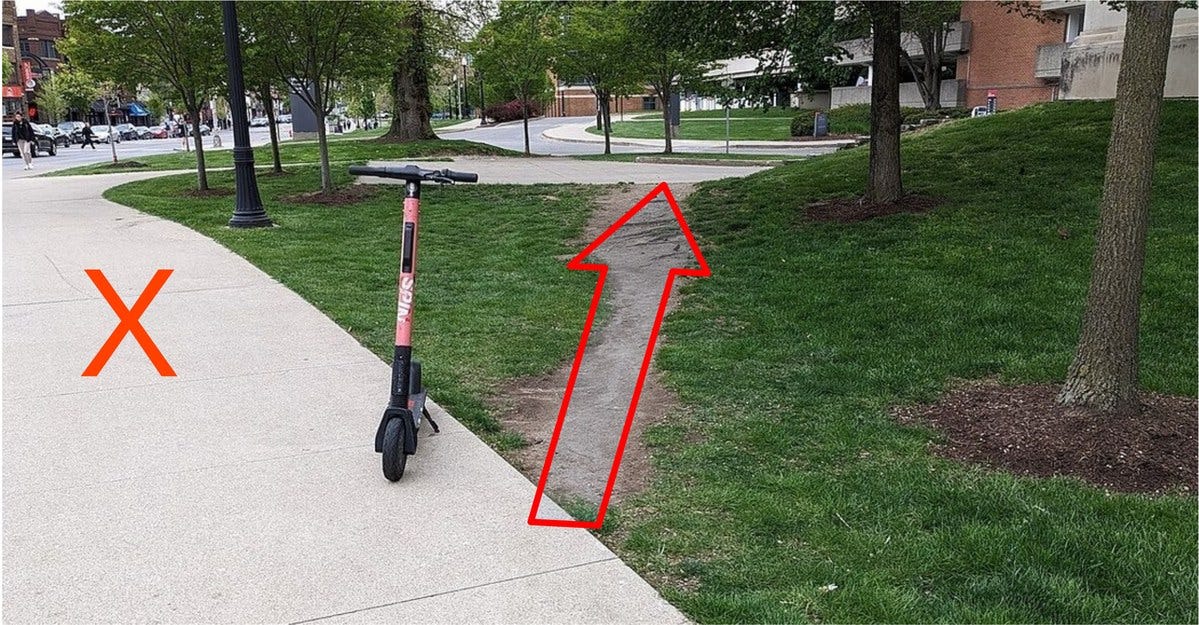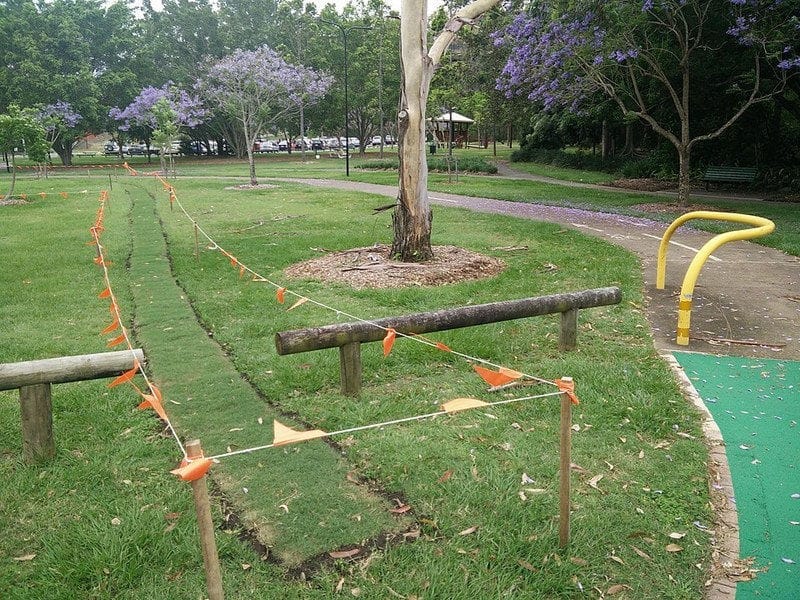Desire Paths
Desire paths are a useful way to examine the usage of outdoor spaces and determine the best layout of paths in these areas.
Desire paths are a useful way to examine the usage of outdoor spaces and determine the best layout of paths in these areas.
So what is a desire path? Desire paths are unofficial, unplanned pathways that emerge because people consistently take the shortest or most convenient route between two points. These paths typically emerge when people repeatedly travel across an area, disregarding the established or designated paths or walkways. The cover image for this post shows a good example of a desire path formed by people cutting straight across the grass (marked by the arrow), rather than walking down the pavement and continuing around the bend (marked by the "X"), which is a less direct route.
Examining these desire paths can provide great insights into how a space is used. In some cases, these desire paths are paved over or incorporated into the design of the space to accommodate user behaviour better. In more natural settings, desire paths are called game trails or use trails and will often later form the basis for an official recreational path. Sometimes, landscape designers will use an existing desire path to design circulation in a space, or leave an area fully unpaved and wait for desire paths to form and then pave those pathways. In Finland, planners have been known to visit parks when the existing paths are covered in snow and examine the footprints to guide the routing of new pathways.
Desire Paths in Home Gardens
In smaller spaces, there is probably a lot less traffic to create these desire paths and they may not be as well defined. If you don't design the circulation of your garden well, you may start to see minor versions of desire paths as visitors to your garden travel through the space.
Even if you don't have any visible desire paths in your garden, try to anticipate where they might form. For example, if there is a driveway in your front garden, is there a direct path from where a car would be parked to the entrance of the home? If there isn't a path, you can expect a desire path to form over time. Similarly, if you have a narrow driveway, there may be corners that are driven over slightly, and rather than constantly replacing some flowers you could lay down some gravel in that area to accommodate the roughing up of the surface by car wheels.
If you have a garden that is older and well-established, you may have some evidence of desire paths that have formed over time. When redesigning these gardens, pay attention to the desire paths and either accommodate them into the design or place obstacles to prevent travel across those areas. If you don't consider these desire paths in your design, you could end up constantly having to repair those areas.
In this image, a desire path was formed by users taking a more direct route. The manager of this park has decided to replace the grass but there will be no good reason for users not to continue taking this route after the grass is repaired and the desire path will likely form again in future.
Obstacles to prevent Desire Paths
Curvilinear design is pleasing to our eyes. However, while a curved path may look attractive it may not be as convenient as taking a direct path and cutting corners. To maintain these curves in your garden space, obstacles can be used to make them feel more natural. Well-placed trees, large shrubs or boulders can make curves feel natural and it will feel like the more desired path than the direct route.
When considering desire paths, prepare to have your design challenged as it is implemented. You may realise that your circulation is not ideal as you move around the space while it is under construction.
An issue like this came up in one of my residential design projects. I was working in a neighbourhood where the homes were set back from the street and mostly had lawns with no fencing or other boundaries on the edges. Our client wanted to replace their lawn with natural landscaping, and the design incorporated paths from the street and their driveway. What we did not realise is that service providers going door-to-door such as delivery drivers were walking across the lawns when going from door to door. After some ground cover was trampled on, we realised there needed to be a deterrent to this travel and we placed large rocks and larger shrubs on the edge of the garden. Hidden behind the shrubs at the back of the former lawn area, we laid down a straight gravel path to provide them convenient access without causing any damage to the planting areas. In doing so, we created a way for these users to travel across the space in the way we wanted them to, without making it overly inconvenient and made it look natural.
Consider existing Desire Paths for a new Garden Design
When planning a new garden layout, look for signs of desire paths. Some may be very well-worn, and some may be less obvious. Consider how these will work with your desired layout but also do some validation.
Some desire paths may exist because of features that are no longer in your garden or will be removed in the new design. For example, there may have been an edible section of the garden with paths leading to and around that area. If this no longer exists or is not going to be part of your new layout, then you can disregard that desire path. Similarly, paths may have formed leading to outbuildings that may no longer exist but the pathways were never repaired.
When reviewing existing circulation by looking at desire paths, you may want to make changes to your design if the path is straight but you would prefer a curved path for aesthetic reasons. If so, give the path a reason to curve by placing obstacles as mentioned above. That said, you should first consider who created that path. I have seen desire paths created by dogs and cats in people's gardens. A well-placed shrub may have no impact on these users of your garden.
For more info and lots of examples of desire paths, check out the desire path subreddit. Here is an example of a feline desire path found on Reddit.




